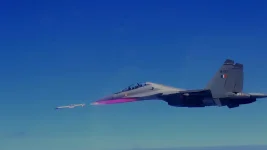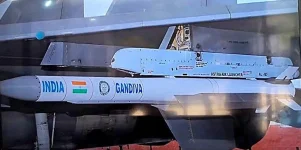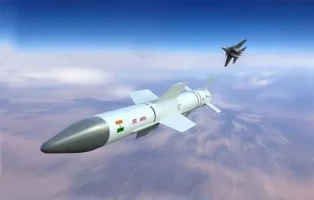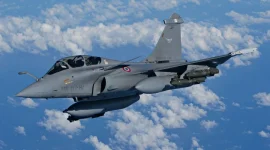- Views: 2K
- Replies: 7
An aerial engagement between the Indian Air Force (IAF) and the Pakistan Air Force (PAF) over the Line of Control (LoC) on February 27, 2019, brought India's air-to-air missile capabilities under sharp focus.
During this clash, which followed India's airstrikes in Balakot, Pakistani F-16 jets equipped with US-made AIM-120C-5 AMRAAM missiles demonstrated a range advantage over IAF aircraft, including Su-30 MKIs using Russian R-77 missiles.
The 2019 confrontation led to the loss of an Indian MiG-21. This outcome highlighted the urgent need for the IAF to enhance its arsenal with longer-range missiles.
Consequently, the air force accelerated the deployment of its domestically developed Astra Mk1 beyond-visual-range (BVR) air-to-air missile to effectively counter the PAF's F-16 fleet and its AMRAAM missiles.
Since then, the IAF has substantially increased its inventory of the Astra Mk1, boosting its combat readiness and reducing dependence on foreign missile systems.
The events unfolded after the IAF targeted a terrorist training camp in Balakot, Pakistan, on February 26, 2019, responding to the Pulwama terror attack. The next day, the PAF launched a counter-operation involving around 25 aircraft, including F-16s, which fired several AMRAAM missiles towards IAF jets from within Pakistan-controlled territory.
The AMRAAM's approximate range of 100 km exceeded the roughly 80 km range of the IAF's R-77 missiles, forcing Indian pilots into defensive actions. It is believed one of these AMRAAMs resulted in the downing of the MiG-21.
This skirmish clearly demonstrated the PAF's BVR advantage at the time, allowing their F-16s to fire from distances beyond the effective reach of the IAF's Su-30 MKIs.
While the Indian Su-30s successfully evaded the incoming missiles through skilled maneuvering, their own missile limitations prevented effective counter-attacks. The incident emphasized the critical requirement for India to possess indigenous BVR missiles with equal or superior range capabilities.
Developed by India's Defence Research and Development Organisation (DRDO), the Astra Mk1 is designed for all-weather conditions and can engage aerial targets up to 110 km away in ideal scenarios.
The missile, measuring 3.6 meters and weighing 154 kg, carries a 15 kg warhead. It employs advanced guidance systems, including inertial navigation and terminal active radar homing, allowing pilots to 'fire-and-forget'.
Capable of reaching speeds up to Mach 4.5 (over four times the speed of sound) and performing high-G maneuvers, the Astra Mk1 significantly closes the capability gap. Its integration with the IAF's Su-30 MKI fleet, which had begun on a smaller scale before 2019, was significantly expedited following the clash.
Since 2019, the IAF has made substantial progress in equipping its fleet with the Astra Mk1. As of early 2025, reports indicate around 400 missiles have been delivered or ordered, with authorization for an additional 200 granted in August 2024, potentially bringing the total near 600.
Primarily integrated with the Su-30 MKI, plans are underway to equip the indigenous HAL Tejas, Dassault Mirage 2000, and MiG-29 fleets as well. A successful test firing from a Tejas Mk1 prototype on March 12, 2025, achieving a direct hit beyond 100 km, confirmed its readiness for the upcoming Tejas Mk1A fighters.
With its stated range matching the AMRAAM, the Astra Mk1 allows IAF fighters to engage PAF F-16s from comparable distances, levelling the playing field. Its high speed and agility make it effective against evasive targets.
Crucially, as a product of indigenous development and manufactured by Bharat Dynamics Limited (BDL), the Astra Mk1 strengthens India's self-reliance (Atmanirbhar Bharat) in critical defence technology, offering a cost-effective alternative to imported missiles.
Furthermore, the integration across multiple IAF platforms enhances operational flexibility. Pairing the Astra Mk1 with fighters like the Tejas, known for its smaller radar signature, could offer tactical advantages.
Meanwhile, Pakistan faces challenges with its aging AIM-120C-5 stockpile, acquired nearly two decades ago, and potential limitations in resupply, reportedly leading them to explore alternatives like Turkish missiles for some aircraft.
The modern design and ongoing production of the Astra Mk1 potentially give the IAF a sustained technological edge.
The rapid buildup of the Astra Mk1 inventory signifies a major step in the IAF's strategy towards achieving technological superiority and self-sufficiency in air combat.
By neutralizing the BVR missile range disadvantage observed in 2019, the Astra Mk1 substantially strengthens the IAF's deterrence and combat capability.





